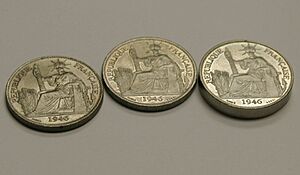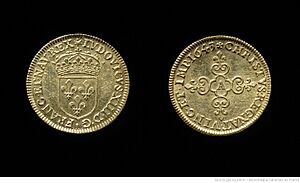Piedfort facts for kids
A piedfort is a super thick coin, often twice as heavy and thick as other coins of the same size and design. These special coins are not used as regular money. Instead, they are made for important people as gifts, or for serious coin collectors. Sometimes, they are also made as test coins by the people who run the mint (where coins are made). You might also see the word spelled "piefort," but "piedfort" is the more common way.
Contents
A Look Back: The History of Piedfort Coins
Piedfort coins first appeared a long, long time ago in France and Great Britain, starting in the 12th century in France. People think these extra thick coins were made so they wouldn't get mixed up with regular coins.
Here are some ideas why the first piedfort coins were made:
- They were used as samples to show what new coin designs would look like before they were made for everyone.
- They helped coin makers in different places see exactly how an approved design should look.
- They were special counting tools for people who worked at the mint.
Later on, because piedforts were so rare, they became special gifts for kings, nobles, and other important people. Did you know that collecting coins was even called "the hobby of kings" back then?
Important coin collectors who had a lot of power wanted these coins. This led to a special rule called a droit de pied fort, which means "right of piedfort." This rule explained who was allowed to get a piedfort version of a new coin design. These rules were written down as early as 1355 in France.
The first British piedforts were silver pennies made when Edward I was king (from 1272 to 1307). Britain stopped making piedforts regularly in 1588. France continued for about 150 more years before stopping too.
But piedforts made a comeback! France started making them regularly again in 1890. Britain began making piedforts available to the public for the first time in 1982. Since then, Britain's Royal Mint has become famous for making many special commemorative piedfort coins. China also made piedforts for collectors in 1988.
What Does "Piedfort" Mean?
The word piedfort comes from two French words: "pied" (which means foot) and "fort" (which means strong, great, or heavy). So, it literally means "heavy foot." But its real meaning is "heavy weight."
In the 1700s, French dictionaries wrote it as two separate words, "pied fort." They described it as a coin "that is thicker than ordinary currency." The modern spelling "piedfort" appeared in English by 1802 and was already widely used.
About the Misspelling "Piefort"
Even though "piedfort" is the correct spelling, you might sometimes see it spelled "piefort." This misspelling became common enough by 1917 that it was mentioned in a dictionary for coin terms.
The "piefort" spelling showed up in English as early as 1893. Some people even made up funny stories about where the word came from, linking it to the weight of a coin, pictures of legs on a coin, or even a city in Belgium!
Even today, some important coin catalogs, like the Standard Catalog of World Coins by Krause and Mishler, have used both "piedfort" and "piefort" interchangeably for many years. Interestingly, the "piefort" misspelling has even found its way back into the French language as "piéfort."
See also
- Glossary of numismatics
- Pattern coin



